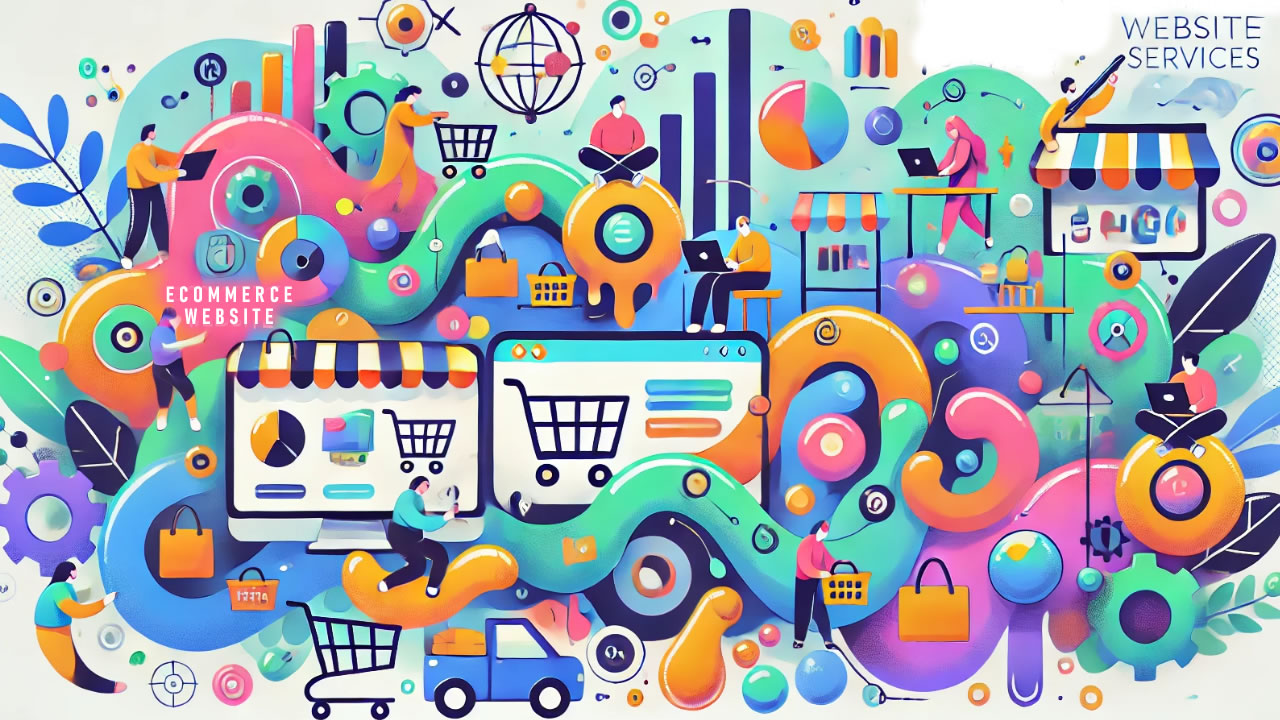Launching an eCommerce website is a significant step toward growing your business, but the work doesn’t stop there. Marketing your eCommerce site effectively is crucial for attracting traffic, generating sales, and building long-term customer loyalty. With the increasing competition in the digital space, eCommerce businesses need to leverage digital marketing strategies that drive results and grow revenue. From pay-per-click (PPC) ads to social media marketing, search engine optimization (SEO), and email campaigns, using the right mix of tactics can significantly boost your eCommerce success.
In this blog post, we’ll discuss the most effective ways to market your eCommerce website and increase sales. We’ll provide key statistics on which advertising platforms work best for eCommerce, offer tips on how to allocate your budget, and explain how you can create a digital marketing plan tailored to your business goals. Finally, we’ll summarize how working with us can help you build, optimize, and market your eCommerce site for maximum profitability.
Why Digital Marketing is Crucial for eCommerce Success
Digital marketing is the backbone of any successful eCommerce business. With more consumers shopping online than ever before, having a strategic marketing plan is essential to attracting and retaining customers. According to Statista, global eCommerce sales reached $5.7 trillion in 2022, and this number is projected to grow steadily. This explosion in online shopping means there’s huge potential, but also increased competition. Without a solid digital marketing strategy, your eCommerce site risks being lost in the crowd.
Here are just a few reasons why digital marketing is key for eCommerce success:
- Build Brand Awareness: Digital marketing helps you reach new audiences, spread brand awareness, and build recognition, even in crowded markets.
- Drive Traffic: Whether through paid ads or organic search, digital marketing drives traffic to your website, providing opportunities for conversions.
- Convert Visitors into Customers: A well-crafted marketing funnel moves potential customers from awareness to consideration and ultimately to conversion.
- Create Customer Loyalty: Digital marketing doesn’t stop at making a sale; it’s essential for building long-term relationships with customers through ongoing engagement and targeted retention efforts.
1. Search Engine Optimization (SEO): Increase Organic Traffic
SEO is one of the most cost-effective ways to drive long-term, sustainable traffic to your eCommerce website. SEO helps your website rank higher in search engine results, allowing you to attract users who are actively searching for the products you sell.
Key SEO Strategies for eCommerce
Optimize Product Pages: Ensure that each product page is optimized with relevant keywords, detailed descriptions, and high-quality images. Use descriptive titles, meta descriptions, and alt tags for images to improve search engine visibility.
Focus on Site Structure and Navigation: A well-organized site structure helps both users and search engines navigate your website easily. Ensure that your product categories and filters are logical, and use internal linking to guide visitors to related products.
Technical SEO: Implement best practices for technical SEO, such as improving site speed, ensuring mobile-friendliness, and setting up an SSL certificate for secure browsing (which is also a ranking factor).
Create High-Quality Content: Publishing blog posts, product guides, and how-to articles can help boost your website’s search rankings. Content marketing also positions your brand as an authority in your niche, driving organic traffic over time.
SEO Statistics for eCommerce
53% of all website traffic comes from organic search, making SEO one of the most valuable digital marketing channels.
eCommerce websites that implement SEO best practices see 2.5x higher conversion rates compared to those that don’t focus on search optimization.
2. Pay-Per-Click (PPC) Advertising: Drive Immediate Traffic
While SEO is a long-term strategy, PPC advertising provides immediate results by placing your products at the top of search engine results and other online platforms. With PPC, you pay each time a user clicks on your ad, making it a powerful tool for driving targeted traffic to your website.
Best PPC Platforms for eCommerce
Google Ads: Google Shopping Ads and Search Ads are highly effective for eCommerce businesses. Shopping Ads display product images, prices, and reviews directly in the search results, making it easy for potential customers to find and compare your products.
Facebook and Instagram Ads: Social media platforms are ideal for targeting users based on their interests, demographics, and behaviors. Facebook and Instagram Ads allow eCommerce businesses to create visually engaging ads that showcase their products and drive conversions. Click here for a comparison of social media ad platforms.
Amazon Ads: For businesses selling on Amazon, investing in Amazon’s PPC platform can help increase your product visibility on the largest eCommerce marketplace.
PPC Tips for eCommerce
Focus on High-Intent Keywords: In your Google Ads campaigns, target high-intent keywords—those that indicate the user is ready to make a purchase, such as “buy,” “shop,” or “order now.”
Use Retargeting: Retargeting ads allow you to show ads to users who have previously visited your website but didn’t make a purchase. This helps bring them back to complete their purchase and is highly effective for reducing cart abandonment.
Optimize Ad Creatives: High-quality visuals, compelling product descriptions, and clear calls-to-action (CTAs) are essential for driving clicks and conversions from your ads.
PPC Statistics for eCommerce
Google Ads: Google Shopping Ads provide 30% higher conversion rates than text-based Search Ads.
Facebook Ads: Facebook ads have an average conversion rate of 9.21% for eCommerce businesses, making it one of the most effective social media platforms for online sales.
3. Email Marketing: Nurture Leads and Drive Repeat Sales
Email marketing is a powerful tool for eCommerce businesses to build relationships with customers, nurture leads, and drive repeat sales. By using targeted email campaigns, you can promote special offers, launch new products, and provide personalized recommendations based on customer behavior.
Email Marketing Best Practices for eCommerce
Segment Your Email List: Divide your email list into segments based on customer preferences, purchase history, or location. This allows you to send highly targeted emails that resonate with each customer group.
Automated Email Campaigns: Set up automated campaigns for different customer journeys, such as welcome emails, abandoned cart reminders, and post-purchase follow-ups.
Incentivize Purchases: Offer exclusive discounts or limited-time offers to encourage subscribers to make a purchase. Adding urgency to your emails can help boost conversions.
Email Marketing Statistics for eCommerce
For every $1 spent on email marketing, businesses can expect an average ROI of $42.
Abandoned cart emails have an average open rate of 45%, and nearly 50% of recipients who click on the email go on to complete their purchase.
4. Social Media Marketing: Build a Community and Increase Brand Loyalty
Social media platforms like Facebook, Instagram, Pinterest, and TikTok are essential for building brand awareness and engaging with potential customers. By creating a social media marketing strategy tailored to your audience, you can increase your brand’s visibility, drive traffic to your website, and foster long-term loyalty.
Social Media Marketing Strategies for eCommerce
Create Shoppable Posts: On platforms like Instagram and Facebook, you can create shoppable posts that allow users to click on products in your images and purchase them directly from your website.
Leverage User-Generated Content (UGC): Encourage your customers to share photos or videos of themselves using your products. UGC serves as social proof, and sharing it on your social channels can increase credibility and trust.
Influencer Partnerships: Partner with influencers in your niche to promote your products. Influencer marketing is highly effective at reaching new audiences and driving sales through trusted recommendations.
Social Media Statistics for eCommerce
71% of consumers who have a positive social media experience with a brand are likely to recommend that brand to others.
50% of Instagram users have purchased a product after seeing it in Stories.
5. Content Marketing: Educate and Engage Your Audience
Content marketing is about creating valuable and informative content that answers your audience’s questions and solves their problems. In eCommerce, content marketing can take the form of blog posts, product guides, how-to videos, or buyer’s guides.
Content Marketing Strategies for eCommerce
Create Product Guides and Tutorials: Write blog posts or produce videos that show how your products can be used. This type of content not only educates your audience but also demonstrates the value of your products.
Leverage SEO with Content: Publishing blog content optimized for relevant keywords helps boost your website’s organic traffic. Use keyword research tools like Ahrefs or SEMrush to find topics that align with what your target audience is searching for.
Repurpose Content for Social Media: Take your blog posts, tutorials, or product guides and repurpose them into bite-sized content for your social media channels.
Content Marketing Statistics for eCommerce
Businesses that publish blog content regularly see an average of 126% more leads than those that don’t.
60% of consumers say they’ve been inspired to make a purchase after reading a blog post about a product.
6. Formulate a Budget for Your Digital Marketing Campaign
Allocating your budget effectively is key to running successful digital marketing campaigns. Here’s how you can create a budget plan that ensures your marketing spend delivers the best ROI:
Consider Your Goals and Sales Targets
Are you looking to increase brand awareness, drive traffic, or boost conversions? Your goals will dictate how much you should spend on each marketing channel. Click here to view a list of every Google ad type and when to use them.
Calculate Your Customer Acquisition Cost (CAC)
CAC is the amount you spend to acquire a single customer. Calculate this by dividing your total marketing spend by the number of new customers acquired. Knowing your CAC helps you budget more effectively and optimize your ad spend.
Allocate Budget by Channel
PPC Ads: Allocate a significant portion of your budget to PPC if you want immediate results. Aim for 30-50% of your total budget if paid ads are your primary driver of traffic and sales.
SEO and Content Marketing: Allocate 15-25% to SEO and content creation for long-term traffic growth. These strategies take longer to show results but are highly cost-effective over time.
Email Marketing: Reserve 10-20% of your budget for email campaigns that nurture leads and retain customers.
Social Media Marketing: Allocate 10-20% of your budget to social media ads, especially if you plan to leverage influencers, shoppable posts, or video content.
Track Your Return on Ad Spend (ROAS)
ROAS measures the revenue generated from your ad spend. For example, if you spend $1,000 on Google Ads and generate $5,000 in revenue, your ROAS is 5:1. Aim for a ROAS of 4:1 or higher to ensure your ad campaigns are profitable.
How We Increase eCommerce Sales with Digital Marketing
Digital marketing is essential for the growth of any eCommerce business. From search engine optimization and PPC advertising to email marketing, social media, and content creation, each channel plays a crucial role in driving traffic, increasing sales, and building long-term customer loyalty. By developing a well-rounded digital marketing strategy, you can reach your target audience more effectively and convert visitors into loyal customers.
At NeoChromatic, we specialize in helping eCommerce businesses build high-performance websites and launch digital marketing campaigns that drive real results. Whether you need a custom-designed website, help optimizing your PPC campaigns, or ongoing SEO and content support, we are here to help you every step of the way.
Ready to grow your eCommerce business? Contact us today to get started on building a website and digital marketing strategy that delivers!
Start Advertising Your eCommerce Store
Schedule A CallRead more about eCommerce

WooCommerce vs Shopify: What’s The Best Online Store For Me?

eCommerce Marketing: Proven Strategies to Increase Sales
